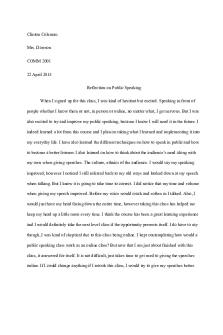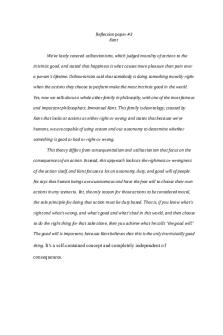Conflict Reflection Paper PDF

| Title | Conflict Reflection Paper |
|---|---|
| Course | Interpersonal Communication |
| Institution | Sam Houston State University |
| Pages | 8 |
| File Size | 113.8 KB |
| File Type | |
| Total Downloads | 72 |
| Total Views | 165 |
Summary
Download Conflict Reflection Paper PDF
Description
1
Conflict Reflection Paper
2 Abstract Conflict is an inseparable, natural part of communication that should be embraced and addressed effectively to build harmonious relationships and avoid stress. In this paper, I try to analyze my ability to handle conflict situations. In particular, I selected one of the minor conflict episodes and attempted to evaluate it through the lens of the conflict theory. The main conclusion that can be made is that avoidance is a dysfunctional approach to conflict resolution that leads to long-term stress and dissatisfaction. No matter how difficult it may seem at first, collaboration is the most suitable conflict style that allows both parties to analyze the problem and find a solution that works equally well for all. Although cultural issues may interfere, due respect and genuine concern for people around can help solve any conflict effectively.
3 Conflict Reflection Paper Any person irrespectively of the character faces conflicts throughout the lifetime. Some are significant and may affect one’s health and emotional well-being for years to come while others are small yet annoying and frustrating. Fortunately, I have faced only minor conflicts in my life, but their deep analysis could help me understand how to cope with greater issues in future and how to behave so that to achieve mutually satisfying results. The purpose of this paper is to analyze one of the conflicts I engaged in several years ago when I shared the room with my friend. In the beginning, I briefly describe the conflict, location, and nature of the conflict. Then I proceed to investigating the problem in detail by utilizing concepts, terms, and ideas from the textbook by Adler, Rosenfeld, and Proctor (2014). By viewing this conflict from the theoretical perspective, I intend to learn more about myself, my approaches to conflicts, and my ability to interact with people. I hope that this information will not only help me understand the theory better but also give me essential communication skills to apply in future. The conflict I analyze in this paper occurred several years ago when I lived with my roommate. She was of the same age, and we had a good time together because we had similar interests and worldviews. However, we lived in a small room where there was simply not enough space for us to feel comfortable, especially given our different daily regimens. Every evening, when I prepared for my classes, she watched movies and talked to her friends on the phone. When I went to bed, she was only starting to work on her assignments. As a result, I was struggling to fall asleep as her lamp was always on, shining on my face. She was always typing something energetically on her laptop, and the sound just drove me mad sometimes. As if all this was not enough, she used to call her boyfriend after she finished her assignments, and they spoke for 15-20 minutes before she went to bed.
4 Although the described situation may look insignificant, it contains all features of a typical conflict defined by Wilmot and Hocker (2013). According to the researchers, conflict is “an expressed struggle between at least two interdependent parties who perceive incompatible goals, scarce resources, and interference from the other party in achieving their goals” (as cited in Adler et al., 2014, p. 369). Researchers argue that for a conflict to exist, all parties must be aware of it. At first, I patiently suffered the noise and did not speak about it with my friend. I thought that it is not her fault that I could not sleep, so it would be wrong to blame her and engage in an open confrontation. However, I think that she eventually learned that I was dissatisfied, although I did not say anything for a long time. Maybe it was my look or the way I behaved that showed my tension and stress. In any case, when I finally spoke about what was bothering me, we both knew about the conflict. There were incompatible goals involved in this conflict. My gain (sleep in the darkness with no noise around) was perceived as my friend’s loss (she could not complete her assignments and could not speak on the phone as much as she wanted). At first, it appeared that someone had to lose, or the whole situation would lead to a serious conflict and longterm stress. There were also scarce resources that fueled the conflict. We lived in a small room, and there was no opportunity for my friend to study elsewhere, just as for me to sleep in a different room. In this conflict, we were interdependent, which means that my welfare and emotional well-being depended on my friend’s actions and vice versa. Finally, as argued by Adler et al. (2014), all conflicts are inevitable, and our situation was no exception. Our conflict was small and seemingly unimportant, but it continued for a long time and could not but affect our relationships. The problem was aggravated by the fact that we used a dysfunctional conflict style, which was not suitable at the moment and could not produce adequate outcomes. We both preferred to avoid discussing the situation openly because of the fear of open confrontation.
5 We had good relationships, so I was afraid that criticism could make my friend feel stressed and angry. I also felt that giving in to the feelings was not an option as I could blow off steam and then regret my behavior. My friend was also silent, although I knew that she was aware of the issue. She tried to be as quiet as possible and limited her phone conversations, but it was not enough for me. Evidently, avoidance was only a means of postponing the inevitable conversation, but we did not realize it at that time. Luckily, our conflict styles changed over the course of the conflict, which allowed us to find acceptable solutions. One evening, before I went to sleep, I spoke about my concerns with the friend. I tried to be as respectful and calm as possible and avoided applying the “Four Horseman” described by Adler et al. (2014): criticism, defensiveness, contempt, and stonewalling. Attacking my friend’s character, denying my responsibility, name-calling, and withdrawing would make the situation even worse and make my friend feel under increased pressure. I wanted her to understand my situation, so I communicated my feelings and emotions clearly and expressed my readiness to work on the problem together. I did not say that it was her fault or that she should change her behavior to suit my needs. Instead, I focused on our interdependence and noted that we need to find options that would satisfy us both. Fortunately, my friend was very understanding and considerate and was willing to make me feel better. After brainstorming, we agreed that she would put the lamp so that it would not bother me and would talk to her boyfriend earlier in the evening. I agreed that I should use earplugs and try to reconsider my attitude to sharing a room. Apparently, I was not prepared to live with someone and thought that it would be as comfortable as living on my own. I was not used to sharing my space with someone and could not handle the situation at first. Collaboration helped me to understand that the room belonged to both of us, so I stopped thinking that I was right, and she was wrong in that case. Surprisingly, it became much easier
6 to cope with stress when I changed attitude to it, and my friend made everything she could to balance our needs. Thus, I can say that collaboration worked perfectly in this case. I do not think that gender affected this conflict much, but I do believe that cultural issues came into play. As argued by Adler et al. (2014), what is acceptable for a person belonging to the Western culture is totally unacceptable for someone from Asia. Indeed, when I finally decided to use the straight-talking, assertive approach to conflict resolution, I was afraid that my friend would take this situation too seriously and would feel extremely uncomfortable discussing the issue. Possibly, the cultural difference was one of the reasons why I kept silent for so long. However, I do not blame my friend and do not believe that my culture was better than hers in this case. We simply had different perceptions of conflict, which is absolutely natural. As a learn more about conflicts and communication approaches, I think that I could handle the conflict episode better if I were to engage in it again. I would not use avoidance anymore because it was emotionally draining me and causing greater distress than the situation itself. I could possibly benefit much from using the seven-step approach described by Adler et al. (2014). Thus, I would (1) define my needs; (2) share my needs with my friend; (3) listen carefully to her needs; (4) generate possible solutions, (5) evaluate them and choose the best one; (6) implement the solution, and (7) follow up this solution. Although we eventually used some of these steps, it would be better to employ this model as soon as the first episodes of conflict occurred. To summarize, the conflict situation analyzed above was an important experience for me that highlighted my communication strengths and weaknesses. It taught me that avoidance is not a solution to the problem and that collaboration is always a win-win solution that fits all genders and cultures. Although it is a minor conflict that all students probably face during the course of their studying, it is critically important to recognize that the skills and
7 knowledge I received can be used for addressing more significant conflicts that may occur in my professional career and personal life.
8
References Adler, R. B., Rosenfeld, L. B., & Proctor II, R. F. (2014). Interplay: The process of interpersonal communication (3th ed.). New York, NY: Oxford University Press. Wilmot, W., & Hocker, J. (2013). Interpersonal conflict (9th ed.). London: McGraw-Hill Higher Education....
Similar Free PDFs

Conflict Reflection Paper
- 8 Pages

Reflection Paper
- 2 Pages

Reflection Paper
- 4 Pages

Reflection Paper
- 2 Pages

Reflection paper
- 3 Pages

Reflection paper for pino
- 2 Pages

Haudenosaunee reflection paper
- 3 Pages

Reflection paper rubric 05
- 1 Pages

Managment Reflection Paper
- 12 Pages

Reflection Paper chapter 5
- 1 Pages

Bev Reflection Paper 1
- 4 Pages

Paul Simon Reflection Paper
- 2 Pages

Reflection-paper-mulanay
- 2 Pages

Reflection Paper Sociology
- 5 Pages

Task 3- Reflection Paper
- 3 Pages
Popular Institutions
- Tinajero National High School - Annex
- Politeknik Caltex Riau
- Yokohama City University
- SGT University
- University of Al-Qadisiyah
- Divine Word College of Vigan
- Techniek College Rotterdam
- Universidade de Santiago
- Universiti Teknologi MARA Cawangan Johor Kampus Pasir Gudang
- Poltekkes Kemenkes Yogyakarta
- Baguio City National High School
- Colegio san marcos
- preparatoria uno
- Centro de Bachillerato Tecnológico Industrial y de Servicios No. 107
- Dalian Maritime University
- Quang Trung Secondary School
- Colegio Tecnológico en Informática
- Corporación Regional de Educación Superior
- Grupo CEDVA
- Dar Al Uloom University
- Centro de Estudios Preuniversitarios de la Universidad Nacional de Ingeniería
- 上智大学
- Aakash International School, Nuna Majara
- San Felipe Neri Catholic School
- Kang Chiao International School - New Taipei City
- Misamis Occidental National High School
- Institución Educativa Escuela Normal Juan Ladrilleros
- Kolehiyo ng Pantukan
- Batanes State College
- Instituto Continental
- Sekolah Menengah Kejuruan Kesehatan Kaltara (Tarakan)
- Colegio de La Inmaculada Concepcion - Cebu
